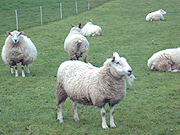|
Dyed in Wool...
|
|
|

|
 |
| BAG'S
FULL:
Fine Merino wool is used to blend Indian wool |
|
ANGORA
Another key area that the CWDB is looking at is that of Angora wool. It was in the early 1960s that the rearing of Angora rabbits started in India. This activity is currently concentrated primarily in the Kullu region of Himachal Pradesh, with smaller concentrations in Punjab, Haryana, Uttaranchal, and Sikkim. Characterised by nascent and essentially small scale and cottage entreprenuership, the sector holds considerable promise as a vehicle for economic betterment. Significantly, it leads to the empowerment of women in these hilly terrains and augments domestic household incomes. The voluntary sector, commendably enough, is not lagging behind. Several NGOs are carrying out some outstanding work in remote, mountainous areas.
Angora rabbitry in India has been enabled by the import in the 1960s and 1970s of rabbit stock of German, British and Russian origin. The Central Sheep and Wool Research Institute, Kullu, and its sub-stations played an important part in the propagation and dissemination of rabbit stock, and in providing technical back up to a large number of small entrepreneurs, as well as to backyard
rabbitaries.Under Indian conditions wool production from Angora rabbits has averaged 600-800 gm annually. This can be bettered as yields in many other parts of the world is considerably higher. But it compares well with sheep wool where average yield is 300-400 gm. Angora is warmer, and capable of being dyed.
|
|

|
|
FURRY
LOGIC: The Chynkara is reared for its soft fur
that is used to make Pashmina cloth |
|
PASHMINA
The premium Pashmina wool is produced in the Ladakh, J and K and Munshiyari region of Uttaranchal under very trying and testing conditions. Farmers in this remote regions have traditionally been exploited by traders and have not received a fair price for their produce. In order to end this exploitation and to provide facilities for processing of the Pashmina wool, a modern Dehairing Plant, inaugurated by the ruling United Progressive Alliance Chairperson Sonia Gandhi, has been set up at Leh at a cost of Rs 8.25 crore.
Of course, the traditional and single largest source of wool remains the sheep. Under the Sheep and Wool Improvement Scheme an integrated approach has been adopted for improvement of wool production and quality. It involves improving stock, health and care of sheep, setting up a system of marketing that recognises and rewards quality. A provision of Rs 3.2 crore was made for six lakh sheep in 2004-05.
Sheep rearing is tough though. Compared to the space-saving infrastructure for breeding rabbits, sheep flocks require large meadows to graze, at times giving rise to niggling inter-state migration problems.
The Councils are the Textile Ministry are helping in exports. A market intelligence network is in place. The well-accepted Woolmark insignia guarantees quality. Under Vaghela textile’s good times are back.
|
|
- EMPIRE FEATURE |
|
|
|
|
|
October 2005
|
|

|
|
|
|